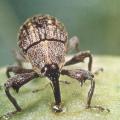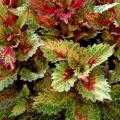News From 2008
MISSISSIPPI STATE -- A small insect pest that drove many cotton farmers nearly to desperation in its heyday is now in desperate straits of its own.
For most of the summer, the state's extensive trap network found only one boll weevil, which was in a Tunica County trap on June 11. Scouts added two more weevils to the 2008 collection in mid-October from traps in Chickasaw County.
By Norman Winter
MSU Horticulturist
Central Mississippi Research & Extension Center
An old masterpiece may be tucked away in your potting shed or garage just waiting for you to bring it to life. This masterpiece is an empty piece of old pottery or even a concrete planter with a chip or two missing and moss or lichens growing on it.
I saw a cool-season container like this a year or two ago that took my breath away. The designer had carefully placed the plant material to create a living work of art.
MISSISSIPPI STATE -- Cotton farmers are trying just to put the season behind them after a year of struggling with the crop once called “king” in Mississippi.
Darrin Dodds, cotton specialist with the Mississippi State University Extension Service, said much of the state's crop looked good until early August, when tropical weather brought untimely rains to areas of the state.
MISSISSIPPI STATE -- A Mississippi scientist and author widely recognized for advancing the study of how insects, spiders, ticks and mites impact human health has joined the faculty of Mississippi State University as associate Extension professor.
MISSISSIPPI STATE -- Individuals involved with tourism development in their communities or those just getting started can learn how to bolster their efforts by attending the Alabama-Mississippi Rural Tourism Conference Oct. 28-29 at the Holiday Inn in Columbus.
The conference is part of a continuing partnership among the Mississippi State University Extension Service, the Alabama Cooperative Extension System and the Tennessee Tombigbee Tourism Association to promote tourism development in Alabama and Mississippi.
MISSISSIPPI STATE -- The Piney Woods Heritage Festival will return Nov. 14 and 15 to the Mississippi State University Crosby Arboretum in Picayune for the first time since Hurricane Katrina.
Relive the Piney Woods region’s early days along the arboretum’s trails with exhibits and demonstrations of traditional blacksmithing, storytelling, woodcarving, spinning, quilting, doll making, Native American artistry, basketry and a host of other skills.
By Norman Winter
MSU Horticulturist
Central Mississippi Research & Extension Center
Muhly grasses native to the southern United States offer dazzling performances for the fall landscape. One of the most picturesque is commonly called Lindheimer's muhly, or blue muhly.
The blue-gray-green color and fine leaf texture would make this grass a winner even if it never bloomed. But it does, sending up plumes on 4-foot-tall plants. The blossoms begin as a creamy pink that turns whiter and finishes tan.
MISSISSIPPI STATE -- Mississippians know to call the Extension Service with questions about insect pests, row crops or family finances, and thousands turn to the same source for training on a variety of other topics.
One topic that has become popular is all-terrain vehicle safety. Many Mississippians are injured and some killed each year in accidents involving ATVs. In late October, two 11-year-old girls died in an ATV accident in DeSoto County, highlighting the need for training in how to safely operate these vehicles.
MISSISSIPPI STATE -- Allergy season can be year-round for many pets, and solutions can be harder to find for small animals than for their human friends.
“With the exception of allergies to fleas and certain foods, people cannot protect their pets from many of the environmental causes of allergic reactions, such as pollens and house dust mites,” said Dr. Juli Gunter, veterinary dermatologist with Mississippi State University's College of Veterinary Medicine. “We often find ways to manage, not cure, their allergic reactions.”
By Patti Drapala
MSU Ag Communications
MISSISSIPPI STATE -- Pumpkins do not grab the headlines as a significant crop, but they fill a niche for many Mississippi farmers who need to supplement cash flow.
“It's best to spread your effort out with several different enterprises because your farm is a business, after all,” said pumpkin producer Clay Meeks of Tippah County, who also grows soybeans and strawberries, and raises cattle. “It helps to have money coming in at different times of the year.”
MISSISSIPPI STATE -- Mississippi is joining other states in an effort to bring attention to renovation safety concerns during National Lead Poisoning Prevention Week, Oct. 19-25.
Jane Clary, Mississippi State University’s Extension Service health specialist, said the Mississippi State Department of Health reports that hundreds of children are poisoned each year by lead, which can cause a variety of health problems, including brain damage and even death.
MISSISSIPPI STATE – The North Mississippi Research and Extension Center will have new leadership beginning Nov. 1 from a longtime Mississippi State University agricultural economist.
Melissa Mixon, interim director of MSU’s Extension Service and the Mississippi Agricultural and Forestry Experiment Station, announced on Oct. 9 that Cary “Bill” Herndon will assume the post, pending College Board approval.
MISSISSIPPI STATE -- Daniel Rivera joined the Mississippi State University team that supports the state’s livestock industry when he accepted a position in September with the MSU Extension Service.
Rivera is the Extension livestock specialist for the southwest district and works from the Central Mississippi Research and Extension Center in Raymond. He is a member of MSU’s Department of Animal and Dairy Sciences.
By Norman Winter
MSU Horticulturist
Central Mississippi Research & Extension Center
The cardoon is a plant the Romans and Greeks ate as a vegetable, but today its popularity is sweeping the South as it is the newest Mississippi Medallion award winner.
Although the ancients ate it, at Mississippi State University's Truck Crops Experiment Station, we use it for its looks. Botanically, cardoon is Cynara cardunculus, and it is related to the globe artichoke.
By Patti Drapala
MSU Ag Communications
MISSISSIPPI STATE -- Mississippi State University professor Ed Martin spent nearly 40 years teaching landscape architecture students to use plants to create great outdoor spaces, and he felt others should understand this principle, too.
Soon after arriving at MSU in 1956, Martin began a partnership with the Garden Clubs of Mississippi to educate people about the function of the landscape. He started a design seminar open to the public.
MISSISSIPPI STATE -- Sweet potato yields and quality appear to be favorable despite rains that have harvest season running seven to 10 days behind schedule.
Calhoun County Extension director Charles Fitts said growers in Mississippi's sweet potato heartland are looking for good weather to finish harvest by the first week in November.
“If rainy weather slows growers down too much, potatoes will be at risk of losing quality when the ground freezes,” Fitts said. “So whenever field conditions are good, growers are working as quickly as possible.”
MISSISSIPPI STATE -- Veterinarian and ABC-TV “Good Morning America” contributor Dr. Marty Becker will bring his popular brand of wit and animal wisdom to Mississippi State University as keynote speaker for the College of Veterinary Medicine’s first ever Nestlé-Purina Human-Animal Bond Lecture Series Oct. 20-24.
"We are thrilled to have Dr. Becker as our keynote speaker,” said Dr. Jennifer Burgess, chair of the lecture series. “We have put together a week-long event that has appeal for anyone who has pets or whose life is touched by animals on farms, at zoos or in the wild.”
By Norman Winter
MSU Horticulturist
Central Mississippi Research & Extension Center
You'll be seeing the stars of next year's gardens and landscapes if you are among the thousands expected to attend the 30th annual Fall Flower and Garden Fest Oct.17-18 at Mississippi State University's Truck Crops Experiment Station in Crystal Springs.
By Patti Drapala
MSU Ag Communications
MISSISSIPPI STATE -- Young people who desire a career in animal health but do not want to pursue a Doctor of Veterinary Medicine degree now have an alternative at Mississippi State University.
MISSISSIPPI STATE -- Researchers may have found the secret to controlling a tiny insect that robs Mississippi landowners of an estimated 12 million cubic feet of pine forest each year.
Though only an eighth of an inch long, the Southern pine beetle is a big pest and difficult to contain. Scientists at Mississippi State University's Forest and Wildlife Research Center, along with colleagues at the University of Wisconsin-Madison, Harvard and the U.S. Department of Agriculture's Forest Service, have made a breakthrough with the discovery of an antibiotic-producing bacterium.
Pages
News Types
- Crop Report (428)
- Feature Story (5905)
- Feature Photo (53)
- Extension Outdoors (320)
- Southern Gardening (1481)
- Extension Inbox (95)
Archive
- 2025 (98)
- 2024 (186)
- 2023 (182)
- 2022 (183)
- 2021 (176)
- 2020 (211)
- 2019 (222)
- 2018 (276)
- 2017 (336)
- 2016 (381)
- 2015 (456)
- 2014 (495)
- 2013 (487)
- 2012 (491)
- 2011 (354)
- 2010 (320)
- 2009 (313)
- 2008 (272)
- 2007 (263)
- 2006 (252)
- 2005 (278)
- 2004 (270)
- 2003 (279)
- 2002 (227)
- 2001 (238)
- 2000 (241)
- 1999 (231)
- 1998 (231)
- 1997 (239)
- 1996 (58)
- 1995 (36)













